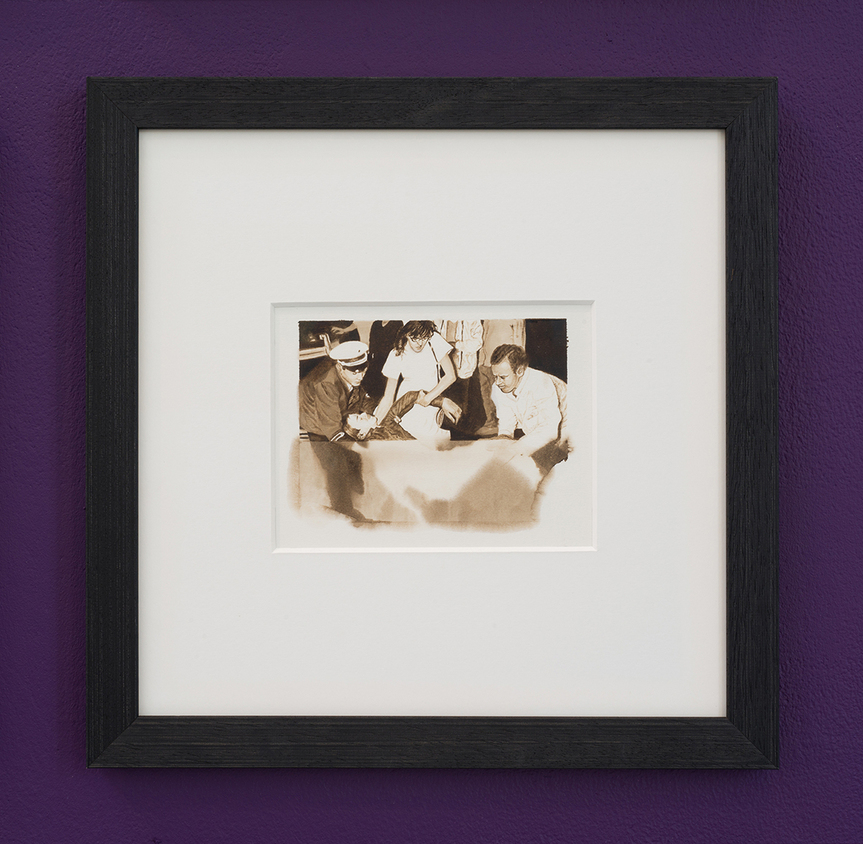-
From Current Issue
-
- Editor’s Letter Fire in the Heart
- Reviews I Gusti Ayu Kadek Murniasih
- Reviews 11th Seoul Mediacity Biennale: “One Escape at a Time”
- Dispatch Networked China
- One on One Monira Al Qadiri on Yukio Mishima
- Essays The rise of independent art spaces in pandemic-era Shanghai
- Features Tuan Andrew Nguyen
- Table of Contents
- Web Exclusives
- Archive
- Subscribe

R
E
V N
E
X
T
SOHEILA SOKHANVARI, “Paradise Lost,” 2017, crude oil on paper, 20 pieces, 38 × 38 cm each. Courtesy the artist and Jerwood Visual Arts Project Space.
Tucked away at Jerwood Visual Arts Project Space on a deep purple wall at the back of Café 171 was Soheila Sokhanvari’s latest commission “Paradise Lost” (all works 2017). The 20 photographs creating the grid are primarily framed drawings inspired by candid photographs of the artist’s family and moments captured during her childhood in Iran, featuring outdoor scenes of leisure by the sea amongst leafy backdrops. However, not all the images are benign. Punctuated with a series of abstract self-portraits and with the discrete insertion of two images recording Iran’s history of revolt and violence, the piece negotiates the complex geopolitics of the region.
The artist’s medium is key to this exploration and her suggestion of the Middle East’s significance on the world stage. Contrary to first impressions, each image is a drawing made using crude oil and in some cases, 22k gold—two of the region’s major exports. These valuable materials, the global connections built around them and their implications for past and contemporary politics, particularly in relation to Iran, are central to Sokhanvari’s areas of research. An element of cynicism is palpable, particularly in A Season of Fury, a diagonally split image that combines a family portrait of three members with one of protestors toppling over the statue of Mohammad Reza Shah Pahlavi. This juxtaposition of images provides insight into the consequences of the country’s oscillating wealth during the late 1960s and ’70s due to an oil windfall in 1973, with a subsequent sharp economic contraction creating discontent that contributed to the Iranian Revolution (1978–79).
Other drawings in the grid expand on the events of this tumultuous period. Benno Ohnesorg 2, found near the lower right-hand corner of the grid, depicts the shooting of Benno Ohnesorg, a German student who was killed by police in West Berlin during a protest of the Shah’s visit to Germany in 1967. Recreating an iconic media image of the student’s limp body being cradled and placed on the ground near Berlin’s opera house, the site of the protest and where the Shah was attending a rendition of Mozart’s The Magic Flute, Sokhanvari recounts the divisive nature of the Shah’s rule. Memorializing this student-led critique, the artist notes the inconsistencies in the ruler’s economic policies, hallmarked by periods of inflation, corruption and personal extravagance, which garnered international attention.
SOHEILA SOKHANVARI, I Sing the Body Electric 3 (Self-portrait 1991), 2017, crude oil and 22 karat gold on paper, 38 × 38 cm. Courtesy the artist and Jerwood Visual Arts Project Space.
The artist’s five self-portrait images, which appear as abstracted geometric forms based on the negative spaces from the drawings, further this critical engagement and analysis of the country’s trajectory. Four of these portraits make up the corners of the grid. The solid shapes are painted in crude oil and gold leaf, patterned with white lines; they are, however, incongruous, and end up being a clumsy distraction from more finely executed oil drawings. This awkwardness is intended, and the visual contrast and simultaneous connection between the subject matter symbolically points to the distance and nostalgic memories of the Iranian diaspora and the impact of displacement on familial relationships.
In the artist’s quiet yet powerful reflection on her past and history of her homeland, the small space dedicated to the display of “Paradise Lost” compromised the strength of its communication. Sokhanavri’s delicate style and micro-scale deserves breathing space, and should find a more sympathetic form of display.
Soheila Sokhanvari’s “Paradise Lost” is on view at Jerwood Visual Arts Project Space, London, until May 13, 2017.
To read more of ArtAsiaPacific’s articles, visit our Digital Library.





